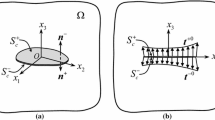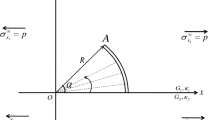Abstract
By applying the new boundary integral formulation proposed recently by Chau and Wang (1997) for two-dimensional elastic bodies containing cracks and holes, a new boundary element method for calculating the interaction between cracks and holes is presented in this paper. Singular interpolation functions of order r-1/2 (where r is the distance measured from the crack tip) are introduced for the discretization of the crack near the crack tips, such that stress singularity can be modeled appropriately. A nice feature for our implementation is that singular integrands involved at the element level are integrated analytically. For each of the hole boundaries, an additional unknown constant is introduced such that the displacement compatibility condition can be satisfied exactly by the complex boundary function H(t), which is a combination of the traction and displacement density. Another nice feature of the present formulation is that the stress intensity factors (both K_I and K_II) at crack tips are expressed in terms of the nodal unknown of H(t) exactly, and no extrapolation of numerical data is required. To demonstrate the accuracy of the present boundary element method, various crack problems are considered: (i) the Griffith crack problem, (ii) the interaction problem between a circular hole and a straight crack subject to both far field tension and compression, and (iii) the interaction problem between a circular hole and a kinked crack subject to far field uniaxial tension. Excellent agreement with existing results is observed for the first two problems and also for the last problem if the crack-hole interaction is negligible.
Similar content being viewed by others
References
Blandford, G.E., Ingraffea, A.R. and Liggett, J.A. (1981). Two-dimensional stress intensity factor computations using the boundary element method. International Journal for Numerical Methods in Engineering 17, 387–404.
Carpenter, W.C. (1984). A collocation procedure for determining fracture mechanics parameters at a corner. International Journal of Fracture 24, 255–266.
Chau, K.T. and Wang, Y.B. (1997). A new boundary integral formulation for two-dimensional elastic bodies containing cracks and holes. Submitted to International Journal of Solids and Structures.
Chou, S.I. (1997). Stress field around holes in antiplane shear using complex variable boundary element method. Journal of Applied Mechanics 64, 432–435.
Crouch, S.L. (1976). Solution of plane elasticity problems by the displacement discontinuity method. International Journal for Numerical Methods in Engineering 10, 301–343.
England, A.H. (1971a). On stress singularities in linear elasticity. International Journal of Engineering Science 9, 571–585.
England, A.H. (1971b). Complex Variable Methods in Elasticity. Wiley-Interscience, London, England.
Griffith, A.A. (1921). The phenomena of rupture and flow in solids. Philosophical Transactions of the Royal Society of London A211, 163–197.
Hong, C.-C. and Stern, M. (1978). The computation of stress intensity factors in dissimilar materials. Journal of Elasticity 8, 21–34.
Hromadka, T.V. II (1984). The Complex Variable Boundary Element Method. Springer-Verlag, Berlin.
Hromadka, T.V. II and Lai, C. (1986). The Complex Variable Boundary Element Method in Engineering Analysis. Springer-Verlag, New York.
Isida, M. (1970). On the determination of stress intensity factors for some common structural problems. Engineering Fracture Mechanics 2, 61–79.
Kitagawa, H., Yuuki, R. and Ohira, T. (1975). Crack-morphological aspects in fracture mechanics. Engineering Fracture Mechanics 7, 515–529.
Lazzarin, P. and Tovo R. (1996). A unified approach to the evaluation of linear elastic stress fields in the neighborhood of cracks and notches. International Journal of Fracture 78, 3–19.
Linkov, A.M. and Mogilevskaya, S.G. (1990). Hypersingular integrals in plane problems of the theory of elasticity. Journal of Applied Mathematics and Mechanics (PMM) 54, 93–99.
Linkov, A.M. and Mogilevskaya, S.G. (1994). Complex hypersingular integrals and integral equations in plane elasticity. Acta Mechanica 105, 189–205.
Linkov, A.M., Mogilevskaya, S.G. and Napier, J.A.L. (1997). Multiple interacting curvilinear crack problems: A method of solution and numerical results. International Journal of Rock Mechanics and Mining Science 34, Paper No. 218.
Lu, J.K. (1995). Complex Variable Methods in Plane Elasticity. World Scientific, Singapore.
Mews, H. (1987). Calculation of stress intensity factors for various crack problems with the boundary element method. Proceedings of the 9th International Conference On Boundary Elements 2, 259–278.
Milne-Thomson, L.M. (1968). Plane Elastic Systems. Springer-Verlag, Berlin, Germany.
Murakami, Y. (1993). Stress Intensity Factors Handbook 3, Pergamon Press, Oxford, England.
Muskhelishvili, N.I. (1975). Some Basic Problems of the Mathematical Theory of Elasticity. Noordhoff International, Leyden, Netherlands.
Muskhelishvili, N.I. (1977). Singular Integral Equations. Noordhoff International, Leyden, Netherlands.
Pan, E. and Amadei, B. (1996). Fracture mechanics analysis of cracked 2-D anisotropic media with a new formulation of the boundary element method. International Journal of Fracture 77, 161–174.
Parker, A.P. (1981). The Mechanics of Fracture and Fatigue. E & F.N. Spon Ltd, London.
Portela, A., Aliabadi, M.H. and Rooke, D.P. (1992). The dual boundary element method: effective implementation for crack problems. International Journal for Numerical Methods in Engineering 33, 1269–1287.
Sih, G.C. (1973). Handbook of Stress-Intensity Factors. Lehigh University, Bethlehem, Pennsylvania, USA.
Sirtori, S., Maier, G., Novati, G. and Miccoli, S. (1992). A Galerkin symmetric boundary-element method in elasticity: Formulation and Implementation. International Journal for Numerical Methods in Engineering 35, 255–282.
Snyder, M.D. and Cruse, T.A. (1975). Boundary-integral equation analysis of cracked anisotropic plates. International Journal of Fracture 11, 315–328.
Sokolnikoff, I.S. (1956). Mathematical Theory of Elasticity. 2nd Ed., McGraw-Hill, New York.
Timoshenko, S.P. and Goodier, J.N. (1951). Theory of Elasticity. 3rd Edition, McGraw Hill, New York.
Wang, Y.B. (1993a). A new boundary integral equation method of three-dimensional crack analysis. International Journal of Fracture 63, 317–328.
Wang, Y.B. (1993b). A boundary integral equation method of the axisymmetric problem of an external circular crack. Journal of Lanzhou University 29, 19–24 (in Chinese).
Wang, Y.B. and Chen, W.J. (1993). Interaction of two equal coplanar square cracks in three-dimensional elasticity. International Journal of Solids and Structures 30, 3315–3320.
Weaver, J. (1977). Three-dimensional crack analysis. International Journal of Solids and Structures 13, 321–330.
Wu, K.-C., Chiu, Y.-T. and Hwu, Z.-H. (1992). A new boundary integral equation formulation for linear elastic solids. Journal of Applied Mechanics 59, 344–348.
Author information
Authors and Affiliations
Corresponding author
Rights and permissions
About this article
Cite this article
Wang, Y., Chau, K. A New Boundary Element for Plane Elastic Problems Involving Cracks and Holes. International Journal of Fracture 87, 1–20 (1997). https://doi.org/10.1023/A:1007469816603
Issue Date:
DOI: https://doi.org/10.1023/A:1007469816603




